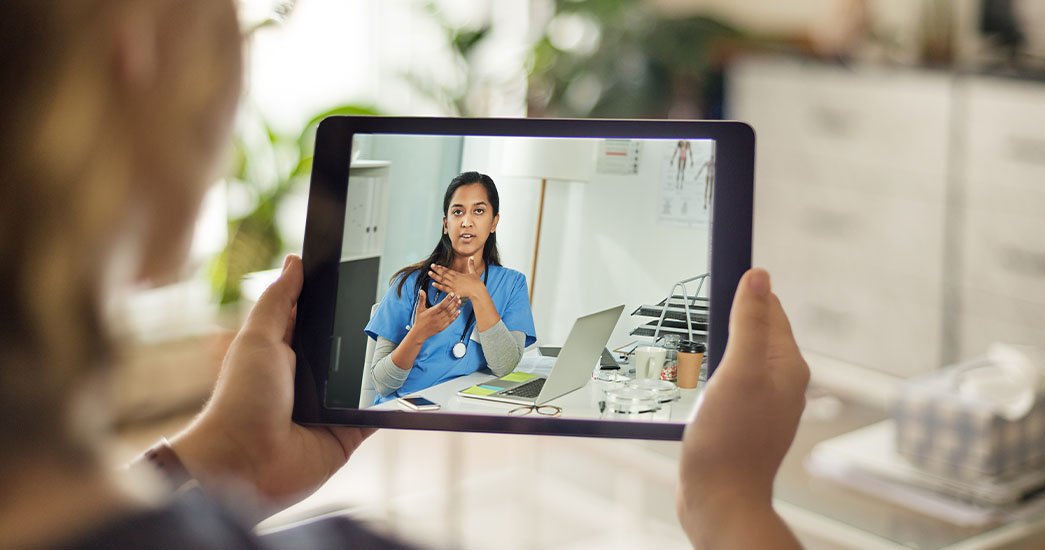
Published September 2019
The way people monitor their own health has evolved. And because smarter tech has given consumers a more holistic view of their overall health, they now expect more digital functionality to be incorporated into their health care benefits. As a result, employers also seek and expect more digital health solutions as part of their compensation benefits.
Rick Weisblatt, chief innovation & strategy officer at Harvard Pilgrim, recently sat down with other leaders in the digital health space to discuss new ways people can proactively and seamlessly care for themselves, from their personal digital devices. We’ve rounded up the highlights from their conversation, but you can watch the full version here.
 Total well being support
Total well being support
The better supported employees feel, the more engaged and productive they will be in the workplace.
HR departments, that are savvy, recognize that their employees’ well-being is a crucial aspect to ensuring their company’s success. Employee engagement and productivity in the workplace is achieved the better employees are supported. Going beyond an employee’s physical health, well-being is also their emotional and financial health, and even their attitudes toward their work and sense of purpose. However, something that is not always an option for employers to offer their employees is onsite programming to address these aspects of well-being and overall health.
“We know that the world of work is very broken today. There is a lot of stress, employees are under a lot of pressure, and that leads to health care issues and problems. We know that 50% of all medical issues have a comorbidity of stress,” says Gary Gustafson, divisional VP of customer success at Limeade, Harvard Pilgrim’s digital partner for the well-being programs it offers to employers.
The immersive platform for employee well-being that Limeade provides shows how mobile technology can be leveraged as a powerful tool to help guide overall wellness. Besides providing trackable health assessments, the tool “gamifies” some well-being elements like nutrition and fitness by creating challenges and games to achieve goals and drive better outcomes. It is able to combine pulse monitors, personal step trackers and other consumer products on one dashboard.
Employees can more easily assess the areas of well-being they want to focus on.
One of the key Limeade platform aspects though, is that it can offer recommendations personal to each individual employee that can span well beyond the traditional wellness goals like losing weight or eating healthier. Limeade’s platform also provides access to tools that help to manage stress and anxiety through webinars, mindfulness exercises and daily check-ins. With this, employees can more easily assess the areas of well-being they want to focus on, access supporting resources and tools and accomplish their goals – at their own pace, and from their own mobile device.
 Guided diagnoses and action plan
Guided diagnoses and action plan
At a time, when seemingly endless information is available at our fingertips, there’s an ongoing struggle between seeking information about one’s health and (many times inaccurately) self-diagnosing a condition. Whether a mental health issue or nagging pain, on-demand symptom analysis and guidance on next steps based on diagnosis and personal health benefits can help your employees access the right medical help they need.
The problem we’re trying to solve is that people don’t know what to do when they’re sick.
“The problem we’re trying to solve is that people don’t know what to do when they’re sick,” explains Dr. Andrew Le, CEO & co-founder of Buoy Health. “And so 72 percent of Americans do what everyone else does, which is they turn to Google. And of the stuff they read online, 54 percent of that information is inaccurate. And what ends up happening is they mislead themselves into going to the wrong care at the wrong time. So if you just look at emergency room visits, 56 percent of them are non-urgent. Thirty-one percent of urgent care visits could have been treated telephonically.”
Buoy is differentiated in the space of digital health assistants because of its ability to move forward from symptom analysis, and integrate actual information about employees’ benefits for guidance on how to best navigate and access a complex health care system.
Many programs that employers offer as part of their health benefits are often underutilized because employees don’t know how to access them in a sea of options.
Many employer-offered programs that are part of their health benefits are often not used often enough because employees are unaware of how to access them with a sea of options. Buoy helps navigate a path to these options (such as telemedicine or other in-network options that are part of an employee’s specific health benefits) as part of the employee’s personalized action plan for treatment. In addition, Buoy also offers a custom profile page where employees can continue in the right direction with access to a record of past ailments and benefit usage – all from their personal device.

 Personal, continuous support for employees with chronic health conditions
Personal, continuous support for employees with chronic health conditions
For employees with daily health care needs, mobile technology is life-changing. “When we thought about the use of technology, we said for these individuals really going through periods of vulnerability, the number-one thing we can do is to help people feel connected and cared for,” says Jake Sattelmair, CEO of Wellframe. “That means meeting emotional and relational needs, not just clinical and informational ones.”
Wellframe works with a health plan’s care management team to provide reminders and tips everyday to help stay on track for those dealing with a chronic condition, while also creating a secure platform where an employee can directly talk with a Nurse Care Manager from their health plan, creating a multi-channel communication approach (and a direct human connection) to responding to questions about benefits and coverage and managing care. Through Wellframe, employees can communicate directly with their health plan’s care team through HIPAA-compliant two-way messaging, SMS text, video chat and email.
Through Wellframe, employees can communicate directly with their health plan’s care team through HIPAA-compliant two-way messaging, SMS text, video chat, and email.
Also increasing in popularity are apps that help support the targeted management of specific chronic conditions. An example of one is GlucoseZone by FitScript. Available to all Harvard Pilgrim members in Connecticut, GlucoseZone by FitScript offers digital consultations with a diabetes coach to individuals living with Type 1 and Type 2 diabetes. This coach can then customize diet and exercise programs that account for real-time blood sugar levels, and help track success from an interactive screen. “When you actually provide patients with tools for fitness therapy that’s based on their real-time blood sugar levels and factor in their medications, you have astounding results. One patient reduced their medication consumption by $39,000 a year,” explains Charlie O’Connell, GlucoseZone by FitScript’s founder & CEO.
One patient reduced their medication consumption by $39,000 a year.
As advancements in digital care continue to evolve, Harvard Pilgrim is committed to staying at the forefront of these innovative offerings to keep your clients happy and healthy. Talk to your Harvard Pilgrim Account Executive for more details on which digital tools are included in your client’s Harvard Pilgrim coverage.
To confirm eligibility for any programs or services mentioned in this article as it relates to your specific health plan, please reach out to your account executive or HR benefits team. You may also speak to our member services team at (888)-333-4742 or by sending a secure email. And for plan details and other member resources, log in to the member portal.